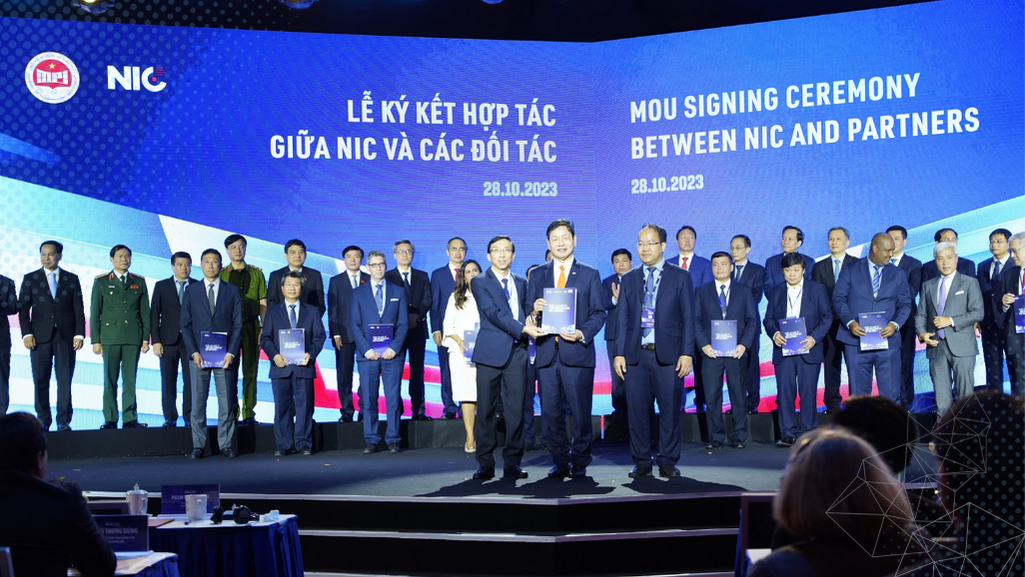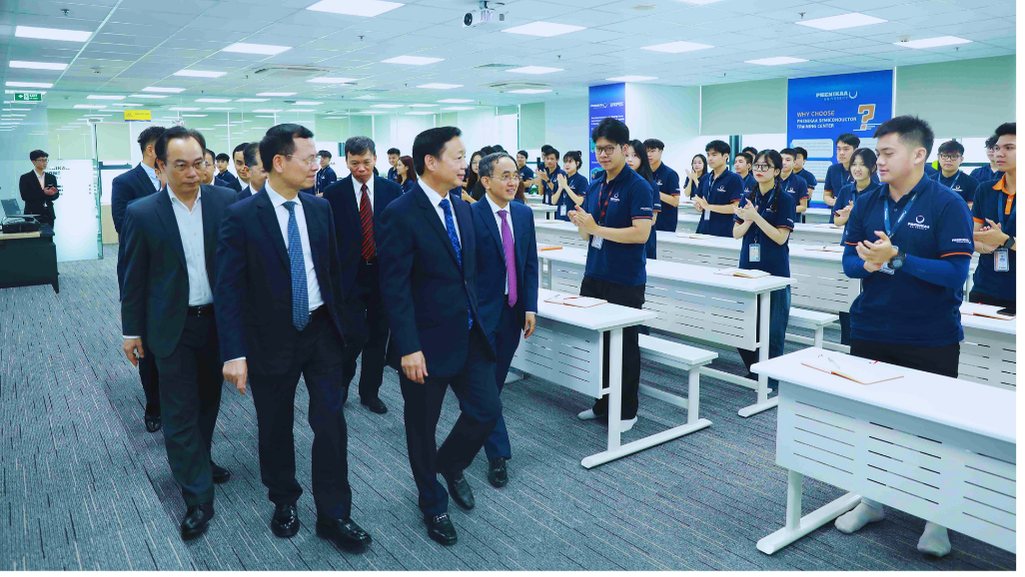

Part 2: Developing Vietnam’s semiconductor workforce depends on a collaborative strategy
Vietnam's Prime Minister Pham Minh Chinh has set a goal of training 50,000 semiconductor engineers by 2030, up from over 5,000 today, to join the global manufacturing value chain.
According to local experts, the key to achieving this goal and contributing to the development of Vietnam's semiconductor human resources is cooperation in training between enterprises and educational institutions.
As an educational institution striving to contribute to this goal, Hanoi University of Science and Technology (HUST) aims to train some 6,000 highly skilled personnel in semiconductor microelectronics by 2030, according to Nguyen Phong Dien, Vice Rector of HUST.
He went on to say that the university offers two training majors, and seven relevant courses with a total of more than 3,300 students. The university provides highly specialized professional training, but it also organizes short-term courses and retrains engineers in some related fields in an effort to expand the number and quality of semiconductor microelectronics workers.
In particular, the University works closely with companies and organizations to develop training programs that are relevant to market needs.
Recently, HUST's School of Electrical and Electronics Engineering has received funding from Siemens through a cooperation agreement between Siemens EDA and the National Innovation Center (NIC) of the Ministry of Planning and Investment (MPI). As a result, 40 to 50 students in the university's first semiconductor chip design major will use Siemens' semiconductor design software.
Nguyen Duc Minh, Vice Dean of the HUST School of Electrical and Electronics Engineering, said the university will use the software in digital circuit design, circuit verification, and analog circuit design courses, and hopes the number of students using the software will increase in the future.
“We hope to collaborate with Siemens to develop digital learning materials and lectures,” he told The Hanoi Times, emphasizing that the partnership between the university and enterprises is one of the important strategies to continuously improve the quality of human resources, especially in the high-tech industry.
Realizing the importance of the link between enterprises and educational institutions for the development of the semiconductor industry, the University of Engineering and Technology-Vietnam National University, Hanoi (VNU-UET) has partnered with South Korea's Samsung Electronics Vietnam (SEV) since the beginning of 2024 to train master graduates in the fields of semiconductors and microchips through the VNU-Samsung Tech Track program.
The university believes that this partnership with a major corporation like SEV provides tremendous opportunities and value in comprehensively training bachelor's, master's, and doctoral students with strong theoretical knowledge and practical skills to meet the future needs of the country and the world. At the VNU-UET, the university trains over 1,000 students annually in fields related to semiconductor microchips.
Nguyen Dinh Duc, Chairman of the University Council of Engineering and Technology at VNU-UET, said that the development of high-quality human resources in this field requires the cooperation of enterprises in training and internship programs, as well as the formation of international research groups in microchip design and semiconductors at universities, research institutes, and enterprises.
Phenikaa University, a rather tardy entrant in this field, has added microchip design as a specialized major in its undergraduate program starting from the 2024-2025 academic year, with the aim of training semiconductor microchip human resources both broadly and deeply based on social needs. By collaborating with strategic partners, the university will focus on research, development, design, and production of smart, advanced, and high-efficiency chip lines for various applications in social life.
Speaking at a recent international conference in Hanoi, Phenikaa University President Ho Xuan Nang said: "Due to the unique nature of the semiconductor industry in general and the semiconductor workforce in particular, highly efficient development cannot be achieved through isolated efforts. Therefore, it is essential to establish strong, mutually beneficial alliances between government agencies, research institutes, universities, and enterprises in the industry.
He emphasized that this is an essential prerequisite for supporting the training of the semiconductor workforce and ensuring the ability to meet society's needs in terms of both quantity and quality.
This close collaboration is accomplished through recent cooperative agreements signed between Phenikaa and prestigious universities such as Arizona State University, Chang Gung University, and companies such as Synopsys, SiCADA, and VMO Holding JSC. The goal is to expand training activities and prepare the workforce for Vietnam and other developed countries.
According to the Ministry of Education and Training (MoET), Vietnam currently has about 35 training institutions specializing in electronic microchips, semiconductors, and related fields, and 11 universities with closely related programs.
According to the Ministry, students pursuing relevant majors can expand their knowledge and eventually enter the semiconductor industry workforce.
Although semiconductor microchip technology is not a new field of study, as some major universities such as the University of Technology, Vietnam National University - Ho Chi Minh City, and Hanoi National University have already been providing training, the percentage of graduates in this field remains very low. This is largely due to limited career opportunities and the quality of education not meeting the needs of enterprises, local insiders said.
Nguyen Duc Minh from HUST explained that the field of semiconductor microchips is a challenging field that is not easy for students to grasp, as it requires extensive practical experience for them to deeply understand the knowledge. However, there are not many active projects in this field for them to apply their knowledge.
He added that in order to play an important role in corporate projects, students need to go through a three- to five-year training and project implementation process.
“This is why microchip training is not easy, as it requires workers to have a solid foundation in electronics, computer engineering, programming, and computer architecture - skills that are systematically trained in certain majors to immediately meet the requirements of businesses,” he told The Hanoi Times.
Many universities are struggling to put their current training programs into practice because they lack high-quality faculty, learning resources (such as lectures and labs), physical resources (such as microchip test equipment), and long-term capital to produce prototypes of the chips they design while students are still in school, Minh said.
He commented that what is lacking are the practical tools to approach the level of the global industry, as the investment cost to purchase the practical tools is quite high.
"We want to make prototypes related to microchips, but it is quite expensive to do so in Vietnam, and we have not been able to do so yet," he pointed out.
He added that the university's faculty is mostly trained abroad. The curriculum content is quite up-to-date. As one of the postgraduate training institutions, the university has a long-standing microchip design training program, and students who complete a three- to six-month training course can fit into the company's business environment and work on the company's projects, Minh said.
"In order to adapt our training to the needs of companies, we regularly survey their requirements and develop training programs and short courses to enhance the skills of our students," he emphasized.
Working with Amkor Technology, the university has found that personnel in this field require different levels of expertise, such as technicians to operate machines, design verification engineers, and specialized engineers to analyze defects in the semiconductor industry. Our training depends on the needs of the businesses, Minh said.
"However, design engineers need a more comprehensive training program," he said.
He added that priority should be given to expanding the training of microchip design engineers, while those involved in production and packaging, such as electrical, automation, and related fields, need only about six months of training to meet the requirements.
"In the near future, we will offer advanced short-term specialized courses for engineers who want to work in microchip design or semiconductors," Minh told The Hanoi Times.
Dao Ngoc Tien, Vice Rector of the University of Foreign Trade, said that at present, technology companies focus on technology, while business schools focus on business. "Therefore, in order to provide complete solutions for organizations and enterprises, there must be cooperation between the parties," he said.
This cooperation is most evident in the cooperation between some major universities and the NIC in implementing a training course for teachers called "Train the Trainers," said Minh from HUST.
He also highlighted the establishment of an alliance of universities that train semiconductor human resources to share resources on teaching materials, electronic textbooks, or jointly develop these curricula. To this end, his university recently signed a cooperation agreement with four prestigious higher education institutions with the support of the MoET.
He thought there was a need for a common coordinating agency to drive the procurement of a set of design tools, and the NIC is doing a good job of implementing this by working with Synopsys Corporation and Cadence, the world's largest chip design software providers. From there, it supports more than 20 technical universities in Vietnam with design licenses.
"We benefit a lot from this," he said.
In addition, Minh suggested the need to establish a multi-project wafer (MPW) coordinating agency to provide a service to help universities fabricate semiconductor chip prototypes at a lower cost than if the universities did it themselves.
Vietnam has about 50 semiconductor design service companies, most of them foreign-invested, with nearly 5,000 engineers, according to MPI.
Intel, Amkor Technology, and Hana Micron Vina have all set up factories in Vietnam in recent years, and the Dutch company Besi began moving its operations to Vietnam in 2023. In addition to these international companies, several domestic firms such as Viettel, FPT, and VNChip have also joined the Vietnamese market in recent years.
The opportunities for Vietnam and the career prospects for students in this field are promising, as many domestic and international groups plan to expand their activities in the coming years, according to MoET.
Vietnam's FPT Corporation has opened the FPT Edu Global International Student Exchange Center and the Semiconductor Center to train high-quality human resources for the central city of Danang. The FPT complex in Danang currently employs more than 5,000 information technology (IT) software professionals. As a strategic investor, the Group plays a leading role in the development of Danang's IT sector and semiconductor manufacturing industry.
Another Vietnamese group, Viettel, aims to be one of the top 20 chip design companies in Asia by 2035, which will require it to have more than 500 engineers by 2030 and 1,000 by 2035, with more than 20% holding master's degrees or higher.
Marvell, a billion-dollar US chip designer, plans to expand its Vietnamese operations to become one of its top three engineering centers worldwide. Over the past 10 years, Marvell's Vietnamese workforce has grown from a few engineers to 400 people, a 30% increase in eight months, 97% of whom are engineers working on design, verification, and GDSII (design format to manufacturing).
Over the next three years, the company expects to grow its workforce by about 20% annually, with the goal of having 500 engineers on its payroll in the near future, said Le Quang Dam, General Director of Marvell Vietnam, at a meeting in Ho Chi Minh City in May.
Over the past decade, Vietnam has emerged as a crucial hub for semiconductor manufacturing, largely due to substantial investments by Intel and other industry giants, Dr. Majo George, Senior Lecturer, Logistics and Supply Chain Management, The Business School, RMIT University Vietnam, told The Hanoi Times.
"Vietnam's semiconductor workforce has made significant strides in quality and capability, driven by sustained investment, strategic partnerships and a focused national strategy," he underlined. "These efforts will continue to shape Vietnam's role in the global semiconductor industry for years to come."
The Ministry of Information and Communications forecasts that Vietnam's semiconductor industry will exceed US$6.16 billion in value by 2024 and reach US$20-30 billion by 2030.
Local experts said that given the global shortage of semiconductor talent, Vietnam's ability to train skilled workers will become a crucial anchor to keep foreign companies investing in the country. The more abundant and higher quality of human resources, the stronger the anchor is for retaining investment flows into Vietnam.






- Hanoi prioritizes key industrial products
- AI set to drive Vietnam's economic growth in 2025
- AEON Vietnam opens another department store in Hanoi
- Support measures to strengthen Hanoi's small businesses and local industries
- European companies endorse Vietnam as investment destination
- Hanoi's flower market flourishes ahead of Tet 2025


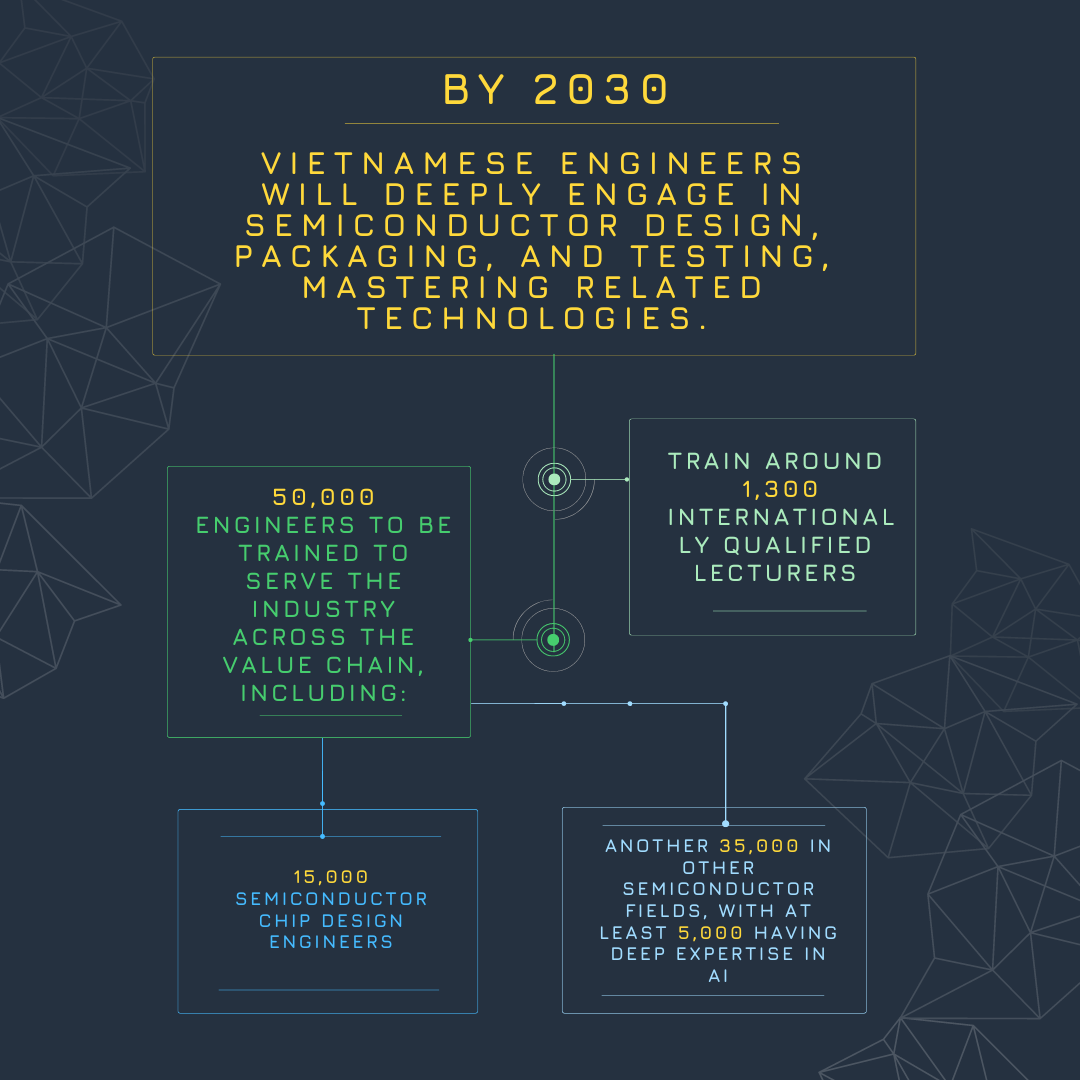

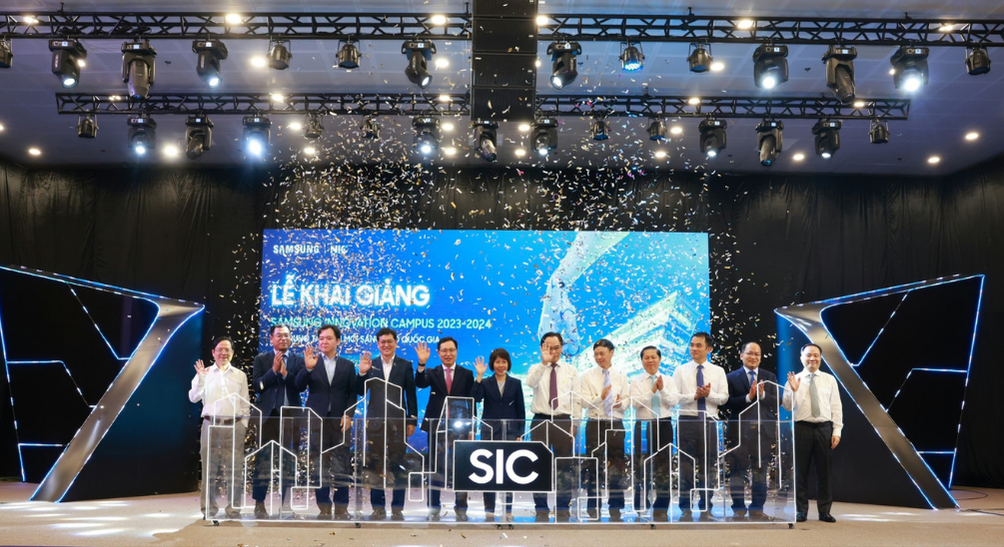



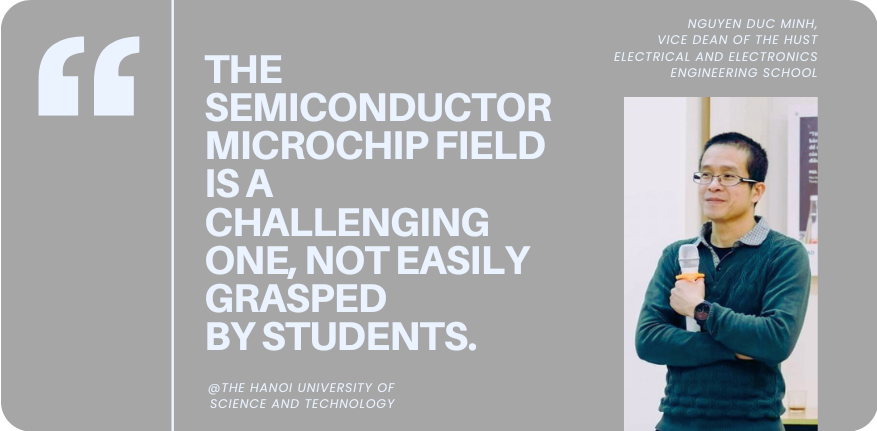
.png)
